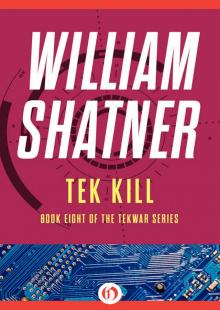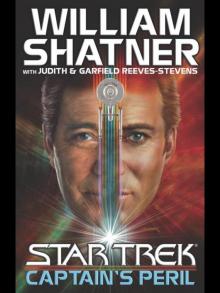- Home
- William Shatner
Captain's Glory
Captain's Glory Read online
Other Books by William Shatner
with Judith & Garfield Reeves-Stevens
Star Trek: Totality
Captain’s Peril
Captain’s Blood
Star Trek: The Mirror Universe Saga
Spectre
Dark Victory
Preserver
Star Trek: Odyssey
The Ashes of Eden
The Return
Avenger
with Chris Kreski
Get a Life!
with Chip Walter
Star Trek: I’m Working on That
POCKET BOOKS, a division of Simon & Schuster, Inc.
1230 Avenue of the Americas, New York, NY 10020
This book is a work of fiction. Names, characters, places, and incidents are products of the authors’ imaginations or are used fictitiously. Any resemblance to actual events or locales or persons, living or dead, is entirely coincidental.
Copyright © 2006 by CBS Studios Inc. All Rights Reserved.
STAR TREK and related marks are trademarks of CBS Studios Inc.
CBS and the CBS EYE logo are
trademarks of CBS Broadcasting Inc.
All Rights Reserved.
This book is published by Pocket Books, a division of Simon & Schuster, Inc., under exclusive license from CBS Studios Inc.
All rights reserved, including the right to reproduce this book or portions thereof in any form whatsoever. For information address Pocket Books, 1230 Avenue of the Americas, New York, NY 10020
Shatner, William.
Star trek. Captain’s glory / William Shatner ; with Judith Reeves-Stevens & Garfield Reeves-Stevens.
p. cm.
1. Kirk, James T. (Fictitious character)—Fiction. 2. Star Trek fiction. 3. Life on other planets—Fiction. 4. Space ships—Fiction. I. Title: Captain’s glory. II. Reeves-Stevens, Judith. III. Reeves-Stevens, Garfield, 1953-IV. Title.
PS3569.H347S6833 2006
813’.54—dc22 2006041625
ISBN-13: 978-0-7434-5375-2
ISBN-10: 0-7434-5375-1
POCKET and colophon are registered trademarks of Simon & Schuster, Inc.
Visit us on the World Wide Web:
http://www.SimonSays.com/st
http://www.startrek.com
Elizabeth and I sat down to dinner with our friends Michael and Jane, and I was reminded how important my friends and family are to me. Gar and Judy, Nen and Frally, Leonard and Susie, Scottie and Tracie, are some of my friends, all of whom are dear to me. To them, whom I treasure, and the treasure of my family, I dedicate this book.
Acknowledgments
Carmen LaVia
Fifi Oscard (in memoriam)
Margaret Clark
But especially Judy & Gar Reeves-Stevens:
the best of the best
…from land and sea on Earth our home
to worlds beyond forever roam;
O hear our plea from reaches far
For those who journey to the stars.
—THE NAVY HYMN
M. BRACK, 2154
Prologue
Hailing Frequencies
U.S.S. ENTERPRISE NCC-1701
STARDATE UNKNOWN
Sometimes it was Harry Mudd, and sometimes it was Kodos. But this time, when the turbolift doors parted, it was the Gorn who charged him.
Kirk stumbled backward as ivory claws slashed the air.
He lost his footing, fell to the deck in the corridor of his ship, scrabbling back to avoid the inevitable.
The Gorn advanced, one heavy, deliberate step after another. Its obsidian blade flashed with each strobe of the red-alert warning lights, gleamed with the deep, rich color of blood.
“I weary of the chase.”
Each word was guttural, hissed.
“Wait for me…I shall be merciful and ssswift.”
Kirk froze, no longer able to move, even to save himself. The Gorn towered over him, arm raised for the killing stroke, its muscles bunched beneath its scales. Its breath enveloped him with the stench of rotting meat, of death, defeat.
But defeat was nothing Kirk could accept, and in his primal rejection of death, he regained control of his body, kicked at the creature’s knees.
Startled by its prey’s defiance, the Gorn twisted to the side.
Kirk seized his chance. Leapt to his feet. Ran from the turbolift.
“We destroyed intrudersss, as I will destroy you!”
But the Gorn’s vicious threat was drowned out by the blare of alarms.
Kirk staggered as the Enterprise shuddered beneath his feet.
Even with no communication with his chief engineer, Kirk knew Scotty was pushing the ship’s engines past their limits. He could feel their vibrations as they strained to break free of the planet’s crushing gravity.
At the same time, Kirk heard the rising howl of wind that told him his ship was entering the atmosphere—a trajectory she’d never survive. Not at this speed without shields to protect her.
“Captain Kirk to the bridge.”
Uhura was calling him, but he had no way of replying. There were no com stations on any of the bulkheads, only phaser and disruptor scorches from the battle with the Klingon boarding party.
Kirk ran down the corridor until he reached another turbolift.
Instinctively, he braced himself as its doors slipped open.
The car was empty.
He rushed inside, twisted the activator.
“Bridge.” The word was little more than a gasp.
“Captain Kirk!”
Uhura’s voice was more insistent. But Kirk still couldn’t answer her. The com station in the turbolift car had been shattered by a sword blade.
The decks pulsed by. The car slowed.
Kirk had just an instant to realize that he couldn’t have reached the bridge so quickly when the doors parted and the Gorn lunged in, a tidal wave of green.
“Earthling captain!”
Kirk ducked and the deadly blade carved empty air as he rammed his shoulder into the Gorn’s chest, trying to force the creature out of the lift. But the doors had already shut. The car began to move again.
Kirk was trapped, nowhere to run.
He blocked the Gorn’s downward stab. He punched the creature’s muzzle. The car rocked as the Enterprise was buffeted by thickening atmosphere.
“To the bridge!” Uhura’s voice cried out over the ship’s speakers.
The next slash of the blade caught Kirk across his chest, slicing his shirt, drawing blood.
The Gorn growled in triumph, struck again.
Kirk moved by training, by instinct, deflected the Gorn’s follow-through by grabbing its massive green hand, forcing the blade back and up and into the creature’s thick neck.
The Gorn’s shriek was deafening in the cramped car. Gouts of purple blood sprayed from the gaping wound as the creature threw itself from wall to wall.
The heat of the dying beast burned into Kirk as the Gorn fell against him, crushing him against unyielding doors.
Kirk struggled to free himself even as the creature’s life ended. The Gorn slid to the floor of the turbolift car. Its huge body shivered once in death, then stilled.
The car slowed.
Kirk looked down at his chest, his shirt smeared with Gorn blood mingled with his own.
The slashing wound was deep. But there was no time to get to McCoy in sickbay. Not with the Enterprise so close to destruction.
So close to death.
The car doors opened.
Kirk ran from the turbolift, onto his bridge.
He called for Uhura.
No answer.
Instead, at he
r station, he saw a white object with pentagonal sides, small enough to fit in his hand.
Instinctively he knew the object was Uhura. She had been reduced to her basic chemical components.
Kirk couldn’t remember why it was important that he had that information. He just knew it was.
His gaze shifted to the main viewscreen, where hellish flames leapt among the stars at warp.
The Enterprise was flying through the galactic barrier. In the very same moment, she screamed through the atmosphere of an unknown planet…at the same time that her engines tore themselves apart while her crew was reduced to—
“It’s a dream!” Kirk shouted his realization, held out his fists in protest. “It’s the dream.”
But this time, unlike all the other times, whether it was Harry Mudd or Kodos who pursued him, the knowledge that he was dreaming was not enough to let him wake.
This time, he still fought to keep his balance on the shifting deck.
Kirk stumbled to his chair, clung to it, staring at the flames on the viewscreen.
“Spock! Analysis!”
Spock turned from his science station, his familiar face ice blue in the glow from his holographic viewer.
“Do I have your attention?” Spock calmly inquired.
“Yes—tell me what we’re facing.” Kirk took a step toward Spock.
But as fast as Kirk could advance, Spock shrank back, receding from him as the bridge itself began dissolving into a cloud of dark sand.
Kirk felt as if he himself were shrinking, his whole existence swirling down some unseen vortex, into the compression of an all-devouring black hole.
“We’re life, Jim,” Spock called from the distance. “But not as they know it.”
Kirk reached out to his friend, wanting, needing, to understand.
“Spock, explain…”
But Spock’s only answer was a far-off echo: “Do I have your attention…”
The instant the black spiral claimed him, Kirk, at last, awoke on his new ship, the Belle Rêve.
He sat up on the side of his bunk in his narrow cabin—the finest on the ship despite its size.
The sweat was cold on his forehead.
His heartbeat thundered in his ears.
The dream had changed. Not just the Gorn…Spock.
And that changed what Starfleet and Admiral Kathryn Janeway had steadfastly refused to believe for more than a year.
Somewhere, Kirk knew beyond doubt, Spock was still alive.
Spock had called out to him.
“We’re life, Jim. But not as they know it.”
Spock had Kirk’s attention.
1
COCHRANE INSTITUTE, NEW MONTANA
STARDATE 58552.2
The citizens of Alpha Centauri B II, who had not thought of themselves as “colonists” for generations, were unprepared for the violence of the first attack. Nor had anyone anticipated the target of that violence.
Only the grove of fig trees planted by the great man himself more than two centuries earlier survived. The rest of the Cochrane Institute lay in ruins.
But the day that ended with the gathering storm of war had begun as any other on a world complacent and too used to peace.
It was late winter in the Northern Hemisphere of New Montana; the stars Centauri A and Centauri B rose together in the dawn. Only during summer is sunlight present for a full twenty-six hours each day. That’s the season when the orbit of Centauri B’s second planet places it between the two larger stars of the ternary Alpha Centauri system.
On the island continent of Atlantis, the early morning then was crisp, the forests of Earth maple and birch bare of leaves, their empty branches little more than quick dark brush strokes against the pure blue canvas of a sky that had not been “alien” to humans for centuries.
Outside the main urban centers of the east coast, smoke trailed from the chimneys of housing clusters. The crackle and scent of burning wood added the sensory texture missing from the island’s efficient geothermal power plants that provided energy to its scattered communities. It was only at the Cochrane Institute that planet-based antimatter generators were used, a requirement of its cutting-edge work in warp propulsion.
More than thirty major buildings formed the main campus, their dusky red forms sweeping up a gentle rise of green foothills. The structures that commanded the hilltops looked out to Lily’s Ocean to the east and the rugged Rockier Mountains to the west. As the first human to journey to Centauri B II, Zefram Cochrane had thoroughly enjoyed exercising his right to name both the planet and its major geological features.
One of the uppermost buildings was a Starfleet installation. The research performed there was restricted, ensuring that Starfleet’s capabilities would always remain significantly more advanced than those of civilian ships, privateers, and any potential “peer competitors”—Starfleet’s current bland term for the restive Klingon Empire.
Officially known as Facility 18, the building was older than the others, constructed almost ninety standard years earlier. Its historic façade of intricately sculpted, red Centauran sandstone was set off by bold horizontal timbers of the pale, native Lincoln trees praised—and named—by Cochrane for producing logs of exceptional uniformity.
Facility 18’s stark and sleek interior, however, revealed signs of regular rebuilding and upgrading. The most recent changes dated from the frantic months toward the end of the Dominion War, eight years earlier. Though the realization was never discussed in public, the leadership of Starfleet was uncomfortably aware that the war’s heavy price for survival had also spurred one of the most productive periods of scientific advancement Starfleet had experienced for generations.
On this date, Middleday, Twelfthmonth 27 on New Montana, Stardate 58552.2 for the Federation at large, Facility 18 was preparing to run a static test on a prototype warp core. Little different in principle from those in service on most Starfleet vessels, the experimental device was notable for its size—almost one-third smaller than the standard design for its payload capacity. The anticipation was that, within a decade at the present rate of development, Starfleet would be able to test runabout-size vessels capable of warp-nine velocities. In terms of travel time, the galaxy grew smaller every day.
The prototype warp core was scheduled to come online at 0800 hours. For this test, it would produce a warp bubble approximately four meters in diameter with a field strength of no more than five millicochranes. These specifics were important: A warp field that weak would not be able to pop out of the planet’s relativistic frame. Even more significant, the core would remain motionless as researchers measured the field’s shape and stability, and the efficiency of the miniaturized synthetic-dilithium matrix—one of the keys to the warp core’s smaller size.
If the test were successful, space trials would follow, with the prototype warp core installed on a test sled.
But the test was not successful, and Starfleet’s Advanced Warp Development Group paid the price of that failure.
Commander Tresk Drumain was a third-generation Starfleet engineer, and the lead investigator on the current prototype tests. He had arrived at Facility 18 at noon the day before, and had worked through the night to prepare the prototype core for the static test.
As the time for the initialization approached, Drumain needed no coffee or other stimulant to stay awake. He was thirty-four standard years old, and the excitement and the challenge of the moment were more than enough to keep him alert. Even making commander by age thirty-two hadn’t been as thrilling as this test promised to be.
Drumain felt confident in his team’s preparations. The prototype core was already locked down in the center of the main test chamber—an immense, reinforced, triduranium-sheathed room more than one hundred meters on a side. Even if a miscalculation or a power surge resulted in the core jumping to warp, the chamber was aligned so that the planet’s own rotation would cause the core to slam into a vast reservoir containing four hundred thousand liters of water. T
hat reservoir was built into the grassy hillside to the east of Facility 18. Because the core’s power supply remained outside the warp field, the field would collapse instantly, allowing for no more than a few hundred meters of travel.
There was no need for concern.
At 0750, in the dimly lit control room overlooking the test chamber, Drumain took his chair at the main monitoring console. As scheduled, the triduranium blast shield slid silently over the large observation window. Now the test core was visible only on the rows of console monitors displaying visual sensor readings from inside the chamber.
Three hours earlier, the atmosphere had been pumped out of the test chamber, leaving the core in a vacuum that was almost the equal of interstellar space. The visual images from inside the chamber were sharp and clear.
At 0755, Drumain glanced again at the message padd propped on the console so all could see. It held the good luck wishes of Commander Geordi La Forge. The man was a legend in Starfleet, and Drumain and his crew had been surprised and encouraged to realize that one of Starfleet’s greatest engineering geniuses was paying personal attention to what they were attempting here. La Forge had asked to be informed about the test results as quickly as possible, and Drumain looked forward to making that call sometime before lunch.
At 0759, Drumain polled his team—a group of more than fifty Starfleet and institute personnel. Their responses were instant and reassuring. All systems on the test core were checked and ready. All sensors were operational. The antimatter generator was online and producing the required level of power.
Drumain tugged down on his Starfleet jacket as the final few seconds of the countdown proceeded.
Timecode: zero.
Everything occurred exactly as planned.
For eighteen seconds.
That was when a warning alert flashed on Drumain’s board. A minor power surge.
It wasn’t large enough for the computer safety subroutines to automatically shut down the test, but the warning prompted Drumain to keep his hand over the large red “kill” switch.

 Man O' War
Man O' War Shatner Rules
Shatner Rules Leonard
Leonard Captain's Glory
Captain's Glory Captain's Glory зпвш-9
Captain's Glory зпвш-9 Tek Money
Tek Money Spirit of the Horse
Spirit of the Horse Tek Vengeance
Tek Vengeance Spectre
Spectre Zero-G
Zero-G Tek Kill
Tek Kill Collision Course
Collision Course TekLab
TekLab Up Till Now
Up Till Now Captain's Blood
Captain's Blood TekWar
TekWar Tek Secret
Tek Secret Captain's Blood зпвш-8
Captain's Blood зпвш-8 Captain's Peril
Captain's Peril Live Long and . . .
Live Long and . . .